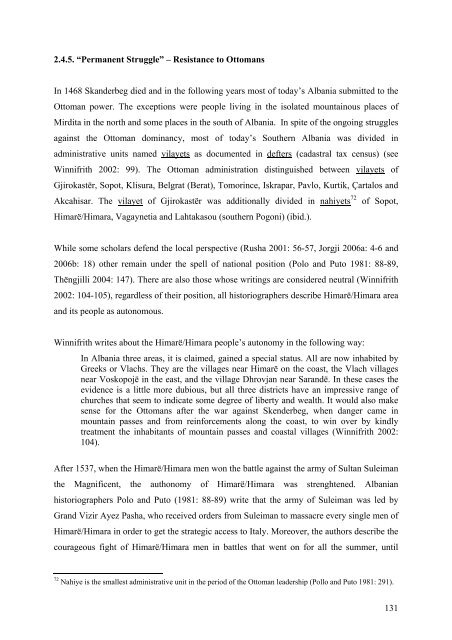university of nova gorica graduate school contested spaces and ...
university of nova gorica graduate school contested spaces and ...
university of nova gorica graduate school contested spaces and ...
Create successful ePaper yourself
Turn your PDF publications into a flip-book with our unique Google optimized e-Paper software.
2.4.5. “Permanent Struggle” – Resistance to Ottomans<br />
In 1468 Sk<strong>and</strong>erbeg died <strong>and</strong> in the following years most <strong>of</strong> today’s Albania submitted to the<br />
Ottoman power. The exceptions were people living in the isolated mountainous places <strong>of</strong><br />
Mirdita in the north <strong>and</strong> some places in the south <strong>of</strong> Albania. In spite <strong>of</strong> the ongoing struggles<br />
against the Ottoman dominancy, most <strong>of</strong> today’s Southern Albania was divided in<br />
administrative units named vilayets as documented in defters (cadastral tax census) (see<br />
Winnifrith 2002: 99). The Ottoman administration distinguished between vilayets <strong>of</strong><br />
Gjirokastër, Sopot, Klisura, Belgrat (Berat), Tomorince, Iskrapar, Pavlo, Kurtik, Çartalos <strong>and</strong><br />
Akcahisar. The vilayet <strong>of</strong> Gjirokastër was additionally divided in nahiyets 72 <strong>of</strong> Sopot,<br />
Himarë/Himara, Vagaynetia <strong>and</strong> Lahtakasou (southern Pogoni) (ibid.).<br />
While some scholars defend the local perspective (Rusha 2001: 56-57, Jorgji 2006a: 4-6 <strong>and</strong><br />
2006b: 18) other remain under the spell <strong>of</strong> national position (Polo <strong>and</strong> Puto 1981: 88-89,<br />
Thëngjilli 2004: 147). There are also those whose writings are considered neutral (Winnifrith<br />
2002: 104-105), regardless <strong>of</strong> their position, all historiographers describe Himarë/Himara area<br />
<strong>and</strong> its people as autonomous.<br />
Winnifrith writes about the Himarë/Himara people’s autonomy in the following way:<br />
In Albania three areas, it is claimed, gained a special status. All are now inhabited by<br />
Greeks or Vlachs. They are the villages near Himarë on the coast, the Vlach villages<br />
near Voskopojë in the east, <strong>and</strong> the village Dhrovjan near Sar<strong>and</strong>ë. In these cases the<br />
evidence is a little more dubious, but all three districts have an impressive range <strong>of</strong><br />
churches that seem to indicate some degree <strong>of</strong> liberty <strong>and</strong> wealth. It would also make<br />
sense for the Ottomans after the war against Skenderbeg, when danger came in<br />
mountain passes <strong>and</strong> from reinforcements along the coast, to win over by kindly<br />
treatment the inhabitants <strong>of</strong> mountain passes <strong>and</strong> coastal villages (Winnifrith 2002:<br />
104).<br />
After 1537, when the Himarë/Himara men won the battle against the army <strong>of</strong> Sultan Suleiman<br />
the Magnificent, the authonomy <strong>of</strong> Himarë/Himara was strenghtened. Albanian<br />
historiographers Polo <strong>and</strong> Puto (1981: 88-89) write that the army <strong>of</strong> Suleiman was led by<br />
Gr<strong>and</strong> Vizir Ayez Pasha, who received orders from Suleiman to massacre every single men <strong>of</strong><br />
Himarë/Himara in order to get the strategic access to Italy. Moreover, the authors describe the<br />
courageous fight <strong>of</strong> Himarë/Himara men in battles that went on for all the summer, until<br />
72 Nahiye is the smallest administrative unit in the period <strong>of</strong> the Ottoman leadership (Pollo <strong>and</strong> Puto 1981: 291).<br />
131

















